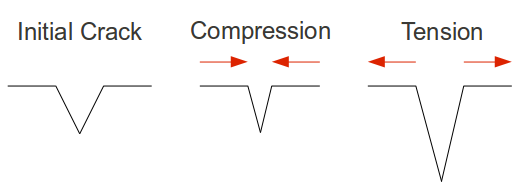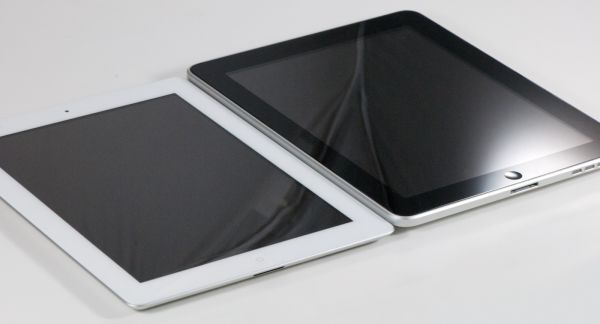The Apple iPad 2 Review
by Brian Klug, Anand Lal Shimpi & Vivek Gowri on March 19, 2011 8:01 PM ESTI asked a friend of mine, Alexander Miles, to write a bit about the properties of glass that really contribute to its overall strength after reading that the iPad 2's glass is 0.62 mm thick compared to 0.85 mm thick in the iPad 1. Hopefully this dispels some myths about glass strength and clarifies. Alex is a senior double majoring in Materials Science and Engineering and Optical Science and Engineering at the University of Arizona.
On the Strength of Glass
We usually think of things failing under compressive stress, being pushed inward from both sides until it they are crushed. Glass and ceramics, it turns out, are incredibly strong in compressive stress. Strictly by the numbers, a fire truck could be supported by a ceramic coffee cup underneath each tire, but only if the load was perfectly downward. Why then are glasses so fragile? This is because no situation causes only compressive stresses, and tensile stress (imagine pulling something from both ends) is what causes glasses to fail. One can think of tiny cracks inside the glass being pushed closed under compressive stress, but torn open under tensile stress.

A schematic illustration of crack behavior in brittle materials.
If you test the tensile strength of thousands of pieces of glass with identical processing and geometry, you will get thousands of different answers. This is markedly different from metals, where you will get nearly the same result every time. The reason being that glass and ceramic materials have a much lower fracture toughness, as much as 100 times smaller than that of a metal. Fracture toughness indicates how easily a crack can propagate, or to phrase it differently, how big a flaw will cause fracture for a given load. As the required load for normal flaw sizes in metals is enormous, metals typically do not fracture in the way glasses do. Metals usually fail in what is called plastic deformation, necking down then tearing away, long before fracture can occur. This plastic deformation is very predictable and follows the stress-strain curve for the given metal, whereas glasses are less predictable.
The question now is, how does the size of a piece of glass affect its behavior under tensile stress? It depends on the distribution of flaws within the material. If you strike a piece of glass with a hammer, a compressive stress is created right below the hammer, but a ring of tensile stress is also created around the spot you hit. You are essentially sampling the distribution of flaws, because if any of the flaws in the affected glass are big enough to widen with the stress you provided, they will rapidly propagate and the material will fracture. The stress field extends down into he material, so flaws in the volume can cause failure as well, though surface flaws are more consistently to blame as the stresses encountered there are almost always larger.

SEM image of a broken glass surface, (CC BY-NC-ND 2.0) attribution St Stev's flickr.
In glasses the distribution of failure stresses is described using Weibull statistics, giving a peak where most samples fail, and tails both on the high and low end where samples had abnormally high and low failure stresses respectively. The long and short of this is that consistently processed samples will have a more narrow distribution as the geometries are scaled down. This means that a thinner piece of glass will have fewer flaws in the bulk and far less likelihood of having a large enough flaw to cause catastrophic failure compared to a thicker piece of glass. The fact that the screens have a large aspect ratio, that is they are far thinner than they are wide or long, means that the effective stiffness will be different in the two directions. Taking this to an extreme, a very thin glass fiber is fairly flexible in bending, but very stiff axially, as its cross-section is so small that very few flaws are contained inside it. If one needs to break a glass fiber, a surface flaw is usually created by scratching it first.
| Approximate values for the strength of common soda lime glass in various conditions | |||||
| Condition | Tensile Strength (MPa) | ||||
| Theoretical Maximum (Flawless) | 9810 | ||||
| 3 Micron Fibers | 3330 | ||||
| Thin rods, fire-polished and acid etched | 3420 | ||||
| Thin rods, no special treatment | 690 | ||||
| Bulk, ion exchange tempered | 350 | ||||
| Bulk, thermally tempered | 300 | ||||
| Bulk, fire-polished and acid etched | 220 | ||||
| Bulk, no special treatment | 50 | ||||
In order to use glass screens on our devices, we would like it to be far tougher, where "tougher'' ideally means both more resistant to fracture as well as more resistant to scratching. There are two basic schemes used to strengthen glass: elimination of the surface flaws, and creation of compressive stress in the bulk of the glass. Eliminating the surface flaws by polishing, fire-polishing (heating them until surface tension flattens out the flaws), and acid-etching does indeed increase the strength, and drastically so. An increase in strength of up to one hundred times can result from such treatment, but is temporary as microscopic scratches from handling will quickly reduce the strength back to what it was before.
The second scheme for improving strength, introducing a compressive layer, works because existing compressive stress in the glass has to be overcome by the induced tensile stress before any cracks can propagate. To say it plainly, if you don't hit it hard enough with a hammer, it will not even see the type of stress that makes it fail. The down side to this method is that every force causes an equal and opposite force, meaning that a lot of compression at the surface causes tension at the center. As long as a crack does not reach the volume with the additional tensile stress imposed on it, the glass will hold together, but once it does it releases the energy kinetically and fails catastrophically (it explodes like a pumpkin with an M80 stuffed in it).
The way this layer is created varies based on the application. For car windshields, they are thermally tempered by chilling the outer surface while the center is still hot, as the surface remains solid while the center is still busy shrinking, which leaves the surface in compression. Similarly, coating the glass object in a second type of glass with a lower thermal expansion will cause the same effect, as the outer surface shrinks the center is shrinking faster. The multiple-glass approach has the additional benefit that cracks have difficultly moving from one type of glass to the next, leading Corning to produce some glasses with as many as 7 layers.
The final method, and most relevant to our discussion, is ion-exchange. Ion-exchange refers to removing small ions, like sodium, from the glass, and replacing them with larger ions like potassium, all at a temperature that prevents the structure of the glass from adjusting itself to these new bigger ions. The way this swap is actually done is by immersing the glass in a molten salt solution containing the ion we want to substitute in, and allowing it to diffuse in over time, while the smaller, more mobile, ion diffuses out. Depending upon the type of glass, the ions being exchanged, and the desired depth, this process can take as long as several days.
The iPad 2 and previous iPad both utilize Corning Gorilla Glass. This type of glass is an alkali-aluminosilicate, being primarily silica and aluminum with an alkali metal, along with other unspecified components mixed in to tweak its properties. The biggest benefit of alluminosilicate glasses, aside from being relatively tough to start with, is the fact that the rate of ion exchange is fairly high even at temperatures low enough that the structure cannot react, meaning it can be processed quickly and create deep protective layers in the glass. The iPad 2 has a modest reduction in the thickness of the glass (about 23% thinner, for those interested) compared to the first iPad, and the question of increased fracture risk has been posed. Given the identical surface quality between the two generations, the reduction of thickness should create no palpable change in toughness for the typical user. That is to say, a drop that would shatter the screen on the original iPad would likely do the same for the new model. That being said, several other design changes appear to account for the change, and might yield better performance in this department.
Where its predecessor used small metal clips to retain the glass screen, the current iteration uses a ring of adhesive around the entire perimeter that not only distributes the load around the glass and prevents scoring at the glass-metal interface, but better couples the stresses into the more compliant aluminum frame. Both of these measures should improve the performance; either way, drop-testing new electronics is generally not recommended.











189 Comments
View All Comments
podperson - Monday, March 21, 2011 - link
Just admit that most PCs are used as toys. Heck, the whole reason the personal computer took off (in homes) was as a games platform.Most of the people I see with PCs are using them to surf the web, watch youtube, update facebook, or mess around with digital media. Where I work there are Macs and PCs available to the public with 27" monitors all open to Facebook (hint, it's a university). Exactly what is this "work" you need to do on PCs? For most people it's a little bit of text editing now.
For some kinds of things the iPad is markedly superior ergonomically to a PC (or even a tablet computer or WACOM tablet display) — e.g. sketching or various musical apps. For others a PC is markedly superior. For still others one or the other is completely useless.
michael2k - Monday, March 21, 2011 - link
Except it isn't bulky nor underpowered for many things.I have a 2006 G4 iBook that is lower performance than a 2010 iPad 2. If the iPad 2 is a toy, then so is just about any early 2006 computer, including older Pentium M based laptops.
It is also far less bulky than self same 4 year old computers, with trivially 2 to 3 times the battery life.
I paid $500 so that my wife can follow my kids around, but still have a computer she can put in her purse. Without the iPad, she would have indeed settled for an iPod touch, but a netbook with a hinge? Too short a battery life and too hard to manage (Windows XP, Windows Update, AV, etc) for the harried housewife/homemaker
bigboxes - Monday, March 21, 2011 - link
Just how big is her purse? As for battery life I think you are looking through rose colored glasses in emphasizing the positive qualities that your device holds. As long as the device lasts until you get home to plug it in (maybe even your vehicle) it will suffice. The iPad is too bulky and not functional enough too do day to day tasks. As I said earlier, the authors point this out.As much as we want these cute devices to succeed we find ourselves using other devices that are far more practical. I've made the same mistake myself in the past. Anyone remember the Sony Clie? Another proprietary underpowered overpriced device. I believe I paid $500 for it. It gathered dust for years until I finally put it in a box. There's the cool factor and then there's reality. Do you set it out for your friends' visits or do you actually get x value out of it?
Also, you are going to be carrying your phone with you already. Why carry both devices with you when one doesn't have more functionality over the other? I would think that the balance for function belongs to the smartphone (phone service is more valuable than screen size).
michael2k - Monday, March 21, 2011 - link
Her purse is big enough to hold an iPad, a wallet, another smaller purse, a phone, keys, two Capri Suns, two candy bars, a small bag of chips, and a couple of diapers.As for battery life, that's exactly what the iPad is; it lasts as long as it needs to until it gets home to be plugged in. I cannot find a laptop under 2 pounds with similar battery life. The minimum requirement is 6 hours.
I carry my phone because I am more like Anand than not. She carries the iPad because she isn't like Anand, at all. It would be the equivalent of me driving a Civic and her driving a minivan; surely the very concept of a soccer mom and her requirements being different than a 9-5 commuter isn't lost on you?
bigboxes - Monday, March 21, 2011 - link
So, we can officially say this is the official tablet of soccer moms everywhere. Yay.She carries it around not because she is unlike Anand. She carries it around because she has a strong back!
vol7ron - Sunday, March 20, 2011 - link
A lot of the "sales" are from the retail outlets and not-necessarily the end-user consumer. There's people that buy it to sell to China or other Asian countries that buy it for double it's price; there are a plethora of reviewers these days; there are the people with mass amount of wealth that buy up anything just because they can; and then the hipsters that want to be cool and fit in. It reminds me of the episode of South Park with the smug Prius drivers.I'm not saying this isn't a bad device and it's mobility makes it beneficial in many regards. But the price of its mobility does not make it as attractive as it would be at the lower price (~$250). I'm not saying it should go for $100, but you're nearing the $1000 end of the spectrum for these devices and way over that for the necessary apps and accessories.
crunc - Monday, March 21, 2011 - link
I don't know why I'm getting into this argument, but all the iPads, including iPad 2's, that I'm seeing out in the world would seem to dispell your notion that no one is actually buying them for their own use. I saw 3 of them within 5 feet of me on the train this morning, for example. In 3 weeks time or so I'll be another one on the train with one, and also using it at home. I don't own a laptop. I wouldn't mind a laptop, but I'd rather have an iPad. It is, for me, far more comfortable to use then a laptop. Even the excellent trackpads on MacBooks don't compare to the entirely touch-based interface of the iPad. Obviously they aren't for everyone, but for some these are a great choice. I don't expect to write a book on it, but I then don't write books. If I ever decide to write a book, maybe I'll get a laptop.Ushio01 - Sunday, March 20, 2011 - link
It's a fasion accessory just like the iphone, to be with the "in crowd" you have to have apple products that's all there is to it. Everyone on here must know at least someone who bought an iphone and then use it only for calls and texts, I know dozens of people who have done this.crunc - Monday, March 21, 2011 - link
Actually, no, I don't know anyone who has an iPhone that only uses it for texts and phone calls. Everybody I know who has one uses it for virtually everything, myself included. In fact, I rarely text and only occasionally make phone calls (mostly of the, "should I pick up a pizza?" variety). You go on living in your little dream world, though. I won't stop you. I have an order in for an iPad 2 and I'm really looking forward to it. I love my iPhone and I want something akin to a laptop, but that isn't that, because the iOS interface is fantastic and the devices are more comfortable for me to use. Sure, there's some shortcomings to the platform, but they are overwhelmed by the multitude of positives.sarahtim - Sunday, March 20, 2011 - link
I think this sort of comment represents a failure of imagination. As iPads sell million after million you have to adjust your idea of how many hipsters there are...Other people are different from you.
Speaking for myself; I find my iPad extremely useful. I use it for a number of hours each day. I don't find it clunky. To me, and this is a very personal thing, the cost was of little consequence. While it is poor taste to blurt out your relative wealth when many folks are having a rough time of it, it is the only way to answer your comment. Further, I consider iPads to be very good value. I bought the bottom of the line iPad 1. It does everything I want. The bulk of its time is spent streaming video via the Air Video app.
I represent a single data point - as do you. I fully appreciate that an iPad is a useless paperweight to you. No problem. When I use my iPad I do it in private. I don't discuss my ownership with others. I don't think I'm clever or a better person because I have one.
You would have to look at me for a very long time before you thought of a hipster. Trust me on this. :-)